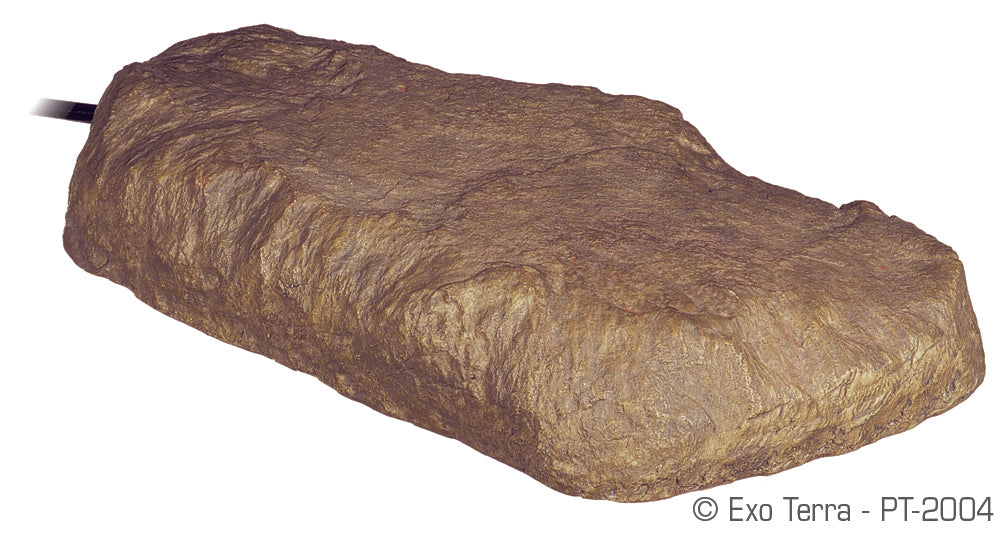
How Heat Rocks Burn Reptiles (and Why You Should Avoid Them)
Many experienced reptile owners will quickly and enthusiastically tell newcomers to the hobby to avoid heat rocks. However, despite this common knowledge, they’re still being sold in stores and purchased by naïve new reptile owners. If heat rocks are supposed to be so bad, then why are they still around? Could this be another folklore husbandry misconception?
The answer is, they really are that bad. Here’s why:
First, you need to know a bit about how reptiles work:
Reptiles have an internal thermostat that dictates their behavior based on their current body temperature relative to their metabolic needs. While they are broadly referred to as “ectotherms,” it’s more correct to say that reptiles are poikilotherms. Unlike thermoconformers, which can’t control their body temperature at all and assume the same temperature as their environment, reptiles actively control their body temperature by traveling between warm and cool areas to maintain a desired core temperature.
This optimum temperature varies depending on the animal’s species, current metabolic needs, and health status. For example, a uromastyx has a higher optimum temperature than a crested gecko. For another example, a ball python that is digesting a meal is likely to maintain itself at a higher temperature than one that isn’t.
Reptiles have evolved to receive and utilize heat from the sun, whether directly (patches of sunlight) or indirectly (sun-warmed objects). In some cases, they receive both at the same time, such as sitting on a rock during the day. In the case of basking in a patch of sunlight, they are receiving even heating in the form of deep-penetrating Infrared-A and Infrared-B from above.
In the case of “basking” on top of a sun-warmed object at night, they are absorbing radiant Infrared-C heat energy that gradually cools down as their body absorbs the warmth. Infrared-C does not penetrate very deeply into animal tissues, making it a less efficient method for the reptile to warm up, but most reptiles that depend on Infrared-C (ambient heat) for warmth are smaller and/or nocturnal and/or have a lower optimum body temperature that they need to attain.
What’s so bad about heat rocks?
Now that you understand a bit about how reptiles work, let’s talk about how heat rocks interact with a reptile’s ability to thermoregulate.
Heat rocks are an artificial rock with a heating coil inside, designed to automatically shut off when a certain surface temperature is reached. Sounds perfectly safe, right? Well, it’s more complicated than that.
Heat rocks produce Infrared-C radiant heat, which as we mentioned before, doesn’t penetrate very far into animal tissue. This means that when a reptile lays on a heat rock, only their skin gets hot, and it’s up to their blood to carry the heat away from the skin and disperse it to the rest of the body. In other words, that heat gets concentrated in the part of the reptile that is in direct contact with the heat rock, and this effect is compounded when the heat rock is smaller than the reptile’s body. When the air is cold, a reptile’s metabolism is slow, which means that the heart is beating slowly and blood doesn’t move around the body very fast. This means that if a cold reptile lays on a heat rock, its blood may not be moving fast enough to carry heat away from the skin fast enough to prevent overheating. And this is how burns happen.
This is assuming that the heat rock in question is evenly heated and functioning correctly. However, just like heat mats, it is possible for hot spots to develop or for the device to malfunction and overheat.
Shouldn’t reptiles be able to sense the pain of their own flesh burning?
Yes and no. Reptile skin senses temperature differently from a human’s. While they can sense sudden, significant temperature changes (touching a very hot or very cold object) and react appropriately, they can’t sense their skin slowly warming or cooling. And even as the flesh on its belly begins to burn, if the rest of the reptile’s body hasn’t reached target basking temperature, then the reptile won’t remove itself from the heat rock. It may not even recognize that the heat rock is the cause of its pain.
This is not because reptiles are stupid, but rather because their bodies did not evolve to gather warmth by sitting on small, hot surfaces that continuously produce heat, especially when the ambient air temperature is relatively low.
Is there any way to make heat rocks safe?
The short answer is that it’s best to avoid heat rocks altogether.
If you want to provide “belly heat” for your reptile, use a heat mat that is larger than its body, connect that heat mat to a dependable thermostat, and place the probe on the surface where the reptile will be receiving the heat.
Better yet, mimic nature by placing a large, flat stone (ex: flagstone or slate tile) under a halogen heat lamp, so the reptile can lay on a warm surface as well as enjoy warm air and deep-penetrating Infrared-A and -B.
Already have a heat rock? Remove its cord and enjoy it as a heatless decoration.

Leave a comment